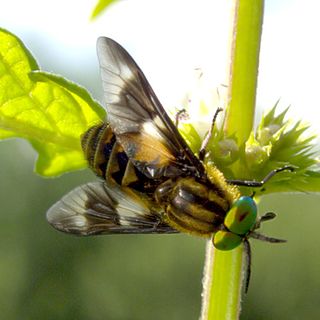Related Research Articles

Superfamily Tabanoidea are insects in the order Diptera.

Haematopota is a genus of flies in the horse-fly family, Tabanidae. Among the horse-flies, they are most commonly known as clegs. Many species have colorful, sinuously patterned eyes in life, a character that fades after death. The wings are typically patterned with spots of grey. The genus is named from the Ancient Greek for blood-drinker: αἷμα, haîma, blood; πότης, pótës, drinker. Some species are known to be vectors of livestock diseases.
In the 10th edition of Systema Naturae, Carl Linnaeus classified the arthropods, including insects, arachnids and crustaceans, among his class "Insecta". Insects with simply two wings were brought together under the name Diptera.

Haematopota pluvialis, the common horse fly or notch-horned cleg fly, or simply cleg in Scotland and northern parts of Ireland, is a species belonging to the family Tabanidae subfamily Tabaninae.

Sargus is a genus of soldier flies in the family Stratiomyidae. There are at least 130 described species in Sargus.

Oxycera is a genus of soldier flies in the family Stratiomyidae. There are at least 80 described species in Oxycera.

Beris is a genus of flies in the family Stratiomyidae. They are small flies with reduced palpi. The scutellum has spines and the abdomen has seven visible segments. Their eyes are contiguous in the male.
References
- Chandler, P.J. 1975. An account of the Irish species of two-winged flies (Diptera) belonging to the families of Larger Brachycera (Tabanoidea and Asiloidea). Proceedings of the Royal Irish Academy Vol.75, Section B, No. 2. Royal Irish Academy. Dublin
- Van Veen Key Illustrated Identification keys
- Harold Oldroyd, 1969 Diptera, Brachycera : section (a) : Tabanoidea and Asiloidea Handbooks for the identification of British insects, v. 9, pt. 4 Royal Entomological Society of London. pdf
- Verrall, G. H., 1909 Stratiomyidae and succeeding families of the Diptera Brachycera of Great Britain- British flies (1909)BHL Full text with illustrations